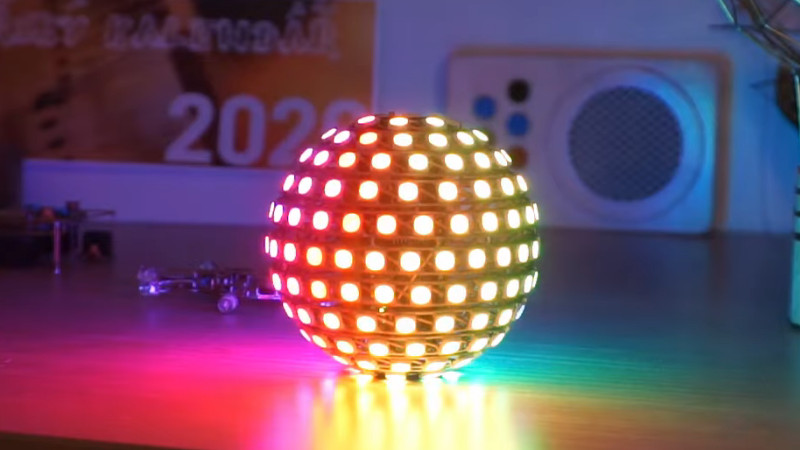We’ve all seen plenty of impressive free-form soldering in these pages, maybe some of us have even had a go ourselves. Using nothing but bare conductors, electronic components, and solder, complex and beautiful electronic sculptures can be created. But the latest free-form project from [Jiří Praus] takes the medium to a new level, as he’s taken no less than 194 bare surface-mount addressable LEDs and formed them into a perfect sphere supported by nothing more than soldered copper wire.
This feat was achieved with the aid of a 3D printed hemispherical jig with spaces for each LED, and each half was assembled in a marathon soldering session. Some significant fault-finding was required due to a few dry joints, and an ESP32 board and Li-Po cell were fitted in between the two halves as they were joined. The result is a triumph, a Christmas bauble like no other, and one which we aren’t sure we could manage to solder so well even on a good day.
If you recognise [Jiří ]’s work, it’s probably because we’ve featured several of his creations previously. It’s always difficult to pick a favorite, but the one which caught our eye the most was his fully functional freeform Arduino Uno.















My back starts hurting just by looking at this; awesome, however
KEWL
The template was a very good idea, as was the method for removing it. Nice job.
Regardless of the extreme coolness of the ball, this is a great video about making in general. The excitement, the challenge, the failure, the determination, the good attitude…. many many kudos
I think I would have rotated the LEDs by 45 degrees to maximize the distance of DIN and DOUT to the power rails and bring DIN and DOUT of adjacent LEDs closer together. And I would probably have used one metal ring for two LED rings. instead of putting VDD and ground rings next to each other.
Two good ideas that would also cut the copper weight by approximately 50%. Since this is touted as a bauble for a Christmas Tree, I would have also off-boarded the power and control for a cleaner look – that number of LEDs is going to drain that battery pack pretty darn quick. I would also have eliminated the holes at the poles.
Right, pole holes are for the Byrds.
Ahhh that funny.
Amazing concept and execution. I’m having as much trouble regarding it as “free form” soldering as I have regarding an arch as free form brickwork though… there was a form.
My back starts hurting just by looking at this awesome
Nice idea and workmanship!
nice job. however, Jenny. please be VERY careful with “next level” kind of comments as those are tightly associated with cheap youtube movies. also avoid titles starting with numbers or titles with questions.
besides, the soldering “an sich” is not on a next level at all. very basic soldering skills used here. its the planning and execution that are interesting
Agreed. The design is audacious and the planning meticulous, but the actual soldering is dubious, relying on solder to bridge gaps and mechanically hold the LEDs in 3 dimensions, whilst using the solder pads in ways that doesn’t create the strong fillets that they were designed for. It’s an awesome project requiring a lot of tedious soldering, and the result is absolutely spectacular – but that soldering is not “next-level”.
An accelerometer inside would make some fun animations possible because you’d always know which way is down. A pattern on the ball could remain vertically oriented, no matter how the ball is moved around by hand or as the ball rolls across a floor. Add a gyro and the pattern could be animated so that it appears to roll opposite the actual rolling of the ball — that might look really cool/confusing!
Is it really in any way free-forM minus the strut prop of the ESP32?
Freaking cool. Tree topper More of a Star than an ornament. Tis the season even if use is ambiguous. Seems to ask for a single axis motion and alot of reflective surfaces.
Nice work and well produced video.
next iteration: RGBW LED’s? or single-color (UV)?
There’s a website that stole his pictures and video clips and are claiming to sell this same ball for 15 bucks…what assholes https://zukunftige.com/products/multi-color-led-crystal-ball
I don’t quite understand. How can they sell this for $16? It’s got too much assembly time. Must be a scam – they probably just take your money.
I can confirm its Scam